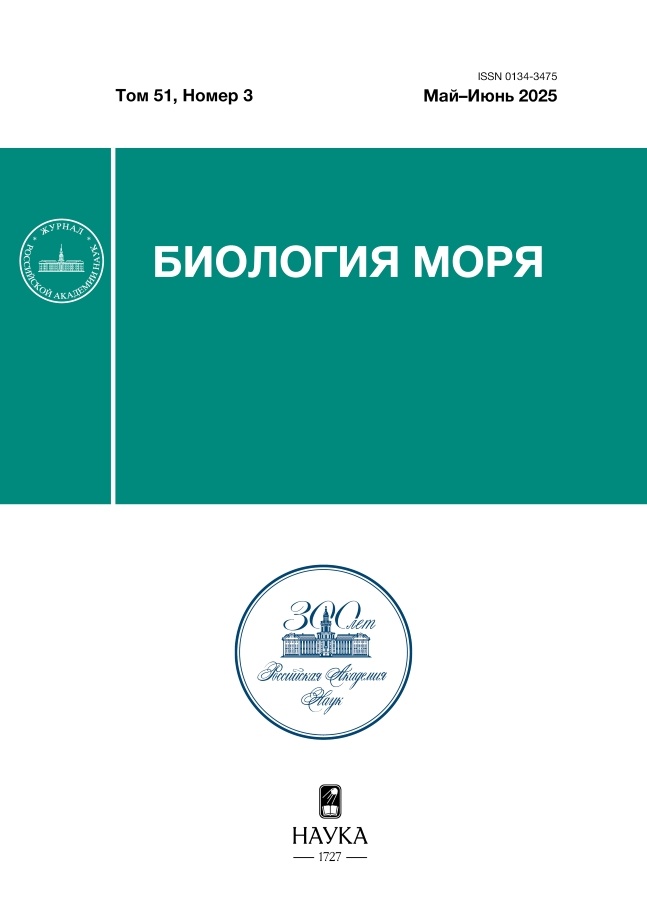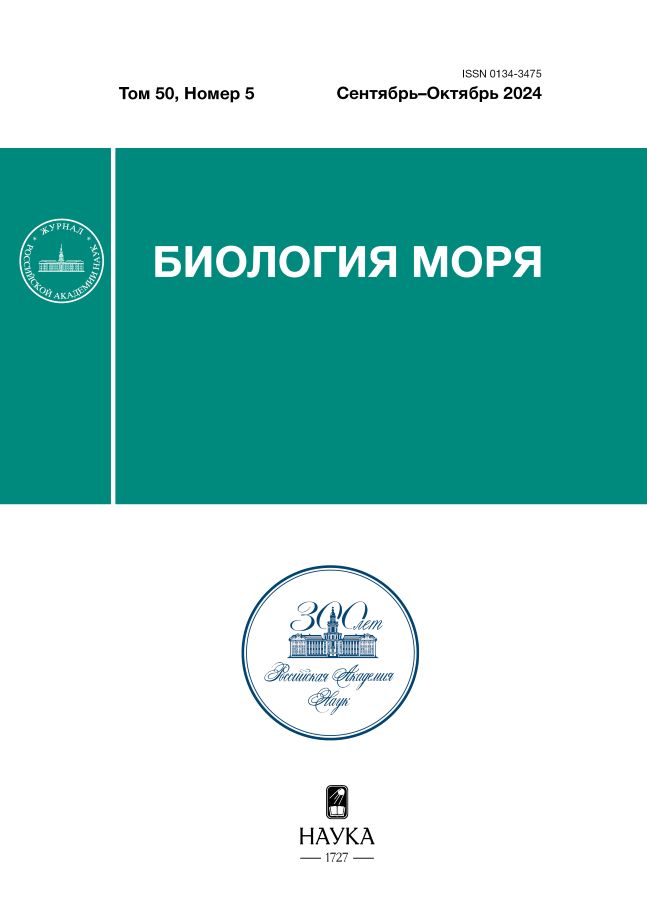Диатомеи как эндофиты морских макроводорослей: разнообразие и взаимоотношения с базифитом
- Авторы: Скрипцова А.В.1, Стоник И.В.1
-
Учреждения:
- Национальный научный центр морской биологии им. А.В. Жирмунского (ННЦМБ) ДВО РАН
- Выпуск: Том 50, № 5 (2024)
- Страницы: 329-336
- Раздел: ОБЗОР
- Статья опубликована: 02.12.2024
- URL: https://permmedjournal.ru/0134-3475/article/view/670309
- DOI: https://doi.org/10.31857/S0134347524050014
- ID: 670309
Цитировать
Полный текст
Аннотация
В обзоре суммируются все известные сведения о видах эндофитных диатомей и их хозяев-макрофитов, приводится история изучения эндофитных диатомей. Обсуждаются механизм проникновения эндофитных диатомей в таллом макроводоросли и влияние, которое оказывают симбионты друг на друга. На основании литературных данных анализируются возможные варианты взаимоотношений между эндофитными диатомеями и базифитом.
Ключевые слова
Полный текст
Об авторах
А. В. Скрипцова
Национальный научный центр морской биологии им. А.В. Жирмунского (ННЦМБ) ДВО РАН
Автор, ответственный за переписку.
Email: askriptsova@mail.ru
ORCID iD: 0000-0001-5943-4522
Россия, 690041, Владивосток
И. В. Стоник
Национальный научный центр морской биологии им. А.В. Жирмунского (ННЦМБ) ДВО РАН
Email: askriptsova@mail.ru
ORCID iD: 0000-0003-1467-0374
Россия, 690041, Владивосток
Список литературы
- Бегун А.А. Видовой состав Bacillariophyta эпифитона макрофитов в заливе Петра Великого (российское побережье Японского моря) // Альгология. 2013. Т. 23. С. 1–23.
- Вассер С.П., Кондратьева Н.В., Масюк Н.П. и др. Водоросли: Справочник. Киев: Наукова думка, 1989.
- Лопатина Н.А., Клочкова Н.Г. Явление эндофитизма диатомовых водорослей у пластинчатых багрянок прикамчатских вод // Сохранение биоразнообразия Камчатки и прилегающих морей: материалы ХVIII междунар. науч. конф., посвящ. 70-летию со дня рождения д-ра биол. н. П.А. Хоментовского. Петропавловск-Камчатский: Камчатпресс, 2017. С. 284–287.
- Одум Ю. Экология: в 2-х т. Т. 2. М.: Мир, 1986.
- Перестенко Л.П. Красные водоросли дальневосточных морей России. СПб.: Ольга, 1994.
- Писарева Н.А., Клочкова Н.Г. Два новых вида водорослей рода Neoabbottiella (Rhodophyta: Halymeniales) из морей российского Дальнего Востока // Биол. моря. 2013. Т. 39. № 6. С. 411–421.
- Рябушко Л.И. Диатомовые водоросли (Bacillariophyta) залива Восток Японского моря // Биота и среда заповедников Дальнего Востока. 2014. Т. 2. С. 4–17.
- Рябушко Л.И., Бондаренко А.В., Широян А.Г. Диатомовые водоросли эпифитона Bryopsis plumosa (Hudson) С. Agardh (Chlorophyta, Bryopsidales) из Чёрного и Эгейского морей // Альгология. 2019. Т. 29. С. 446–462.
- Amsler C.D., Amsler M.O., McClintock J.B., Baker B.J. Filamentous algal endophytes in macrophytic Antarctic algae: prevalence in hosts and palatability to mesoherbivores // Phycologia. 2009. V. 48. P. 324–334. https://doi.org/10.2216/08-79.1
- Apelt G. Die Symbiose zwischen dem acoelen Turbellar Convoluta convoluta und Diatomeen der Gattung Licmophora // Mar. Biol. 1969. V. 3. P. 165–187. https://doi.org/10.1007/BF00353437
- Armstrong E., Rogerson A., Leftley J.W. Utilisation of seaweed carbon by three surface associated heterotrophic protists, Stereomyxa ramosa, Nitzschia alba and Labyrinthula sp. // Aquat. Microb. Ecol. 2000а. V. 21. P. 49–57. https://doi.org/10.3354/ame021049
- Armstrong E., Rogerson A., Leftley J.W. The abundance of heterotrophic protists associated with intertidal seaweeds // Estuar. Coast. Shelf Sci. 2000b. V. 50. P. 415–424. https://doi.org/10.1006/ecss.1999.0577
- Baardseth E. Localization and structure of alginate gels // Proc. Fifth Int. Seaweed Symp. (Halifax, August 25–28, 1966). P. 19–28. https://doi.org/10.1016/B978-0-08-011841-3.50008-2
- Baardseth E., Cuesta M.A. Relationship between the diatom Navicula endophytica Hasle and the brown alga Fucus vesiculosus L., a statistical study // Sarsia. 1983. V. 68. P. 165–169. https://doi.org/10.1080/00364827.1983.1042056
- Baardseth E., Taasen J.P. Navicula dumontiae sp. nov., an endophytic diatom inhabiting the mucilage of Dumontia incrassata (Rhodophyceae) // Norw. J. Bot. 1973. V. 20. P. 79–87.
- Bavestrello G., Arillo A., Calcinai B. et al. Parasitic diatoms inside Antarctic sponges // Biol. Bull. 2000. V. 198. P. 29–33. https://doi.org/10.2307/1542801
- Blackburn M.V., Hannah F., Rogerson A. First account of apochlorotic diatoms from intertidal sand of a south Florida beach // Estuar. Coast. Shelf Sci. 2009a. V. 84. P. 519–526. https://doi.org/10.1016/j.ecss.2009.07.012
- Blackburn M.V., Hannah F., Rogerson A. First account of apochlorotic diatoms from mangrove waters in Florida // J. Eukaryotic Microbiol. 2009b. V. 56. P. 194–200. https://doi.org/10.1111/j.1550-7408.2008.00388.x
- Booth W.E. Navicula climacospheniae sp. nov., an endophytic diatom inhabiting the stalk of Climacosphenia moniligera Ehrenberg // Nova Hedwigia. 1986. V. 42. P. 295–300.
- Bouarab K., Potin P., Weinberger F. et al. The Chondrus crispus–Acrochaete operculata host-pathogen association, a novel model in glycobiology and applied phycopathology // J. Appl. Phycol. 2001. V. 13. P. 185–193. https://doi.org/10.1023/A:1011164031386
- Burkholder J.M., Wetzel R.G.. Microbial colonization of natural and artificial macrophytes in a phosphorus-limited, hardwater lake // J. Phycol. 1989. V. 25. P. 55–65. https://doi.org/10.1111/j.0022-3646.1989.00055.x.
- Burkholder J.M., Wetzel R.G. Epiphytic alkaline phosphatase on natural and artificial plants in an oligotrophic lake: re-evaluation of the role of macrophytes as a phosphorus source for epiphytes // Limnol. Oceanogr. 1990. V. 35. P. 736–747. https://doi.org/10.4319/lo.1990.35.3.0736
- Correa J.A. Infections by pigmented algal endophytes: misuse of concepts and terminology // Rev. Chil. Hist. Nat. 1994. V. 67. P. 5–8.
- Costa M.M.S., Pereira S.M.B., Silva-Cunha M.G.G. et al. Community structure of epiphytic diatoms on seaweeds in Northeastern Brazil // Bot. Mar. 2016. V. 59. P. 231–240. https://doi.org/10.1515/bot-2015-0014
- Cox G., Larkum A.W.D. A diatom apparently living in symbiosis with a sponge // Bull. Mar. Sci. 1983. V. 33. P. 943–945.
- de Stefano M., Romero O.E., Totti C. A comparative study of Cocconeis scutellum Ehrenberg and its varieties (Bacillariophyta) // Bot. Mar. 2008. V. 51. P. 506–536. https://doi.org/10.1515/BOT.2008.058
- Frankovich T.A., Ashworth M.P., Sullivan M.J. et al. Epizoic and apochlorotic Tursiocola species (Bacillariophyta) from the skin of Florida Manatees (Trichechus manatus latirostris) // Protist. 2018. V. 169. P. 539–568. https://doi.org/10.1016/j.protis.2018.04.002
- Halat L., Galway M.E., Gitto S., Garbary D.J. Epidermal shedding in Ascophyllum nodosum (Phaeophyceae): seasonality, productivity and relationship to harvesting // Phycologia. 2015. V. 54. P. 599–608. https://doi.org/10.2216/15-32.1
- Hasle G.R. Navicula endophytica sp. nov., a pennate diatom with an unusual mode of existence // Br. Phycol. Bull. V. 1968. V. 3. № 3. P. 475–480. https://doi.org/10.1080/00071616800650071
- Klochkova T.A., Pisareva N.A., Park J.S. et al. An endophytic diatom, Pseudogomphonema sp. (Naviculaceae, Bacillariophyceae), lives inside the red alga Neoabbottiella (Halymeniaceae, Rhodophyta) // Phycologia. 2014. V. 53. P. 205–214. https://doi.org/10.2216/13-229.1
- Kociolek P.J., Hamsher S.E. Diatoms: by, with and as endosymbionts // Algal and cyanobacteria symbioses. World Scientific. 2017. P. 371–397. https://doi.org/10.1142/9781786340580_0012
- Lee J.J. Algal symbiosis in larger Foraminifera // Symbiosis. 2006. V. 42. P. 63–75. https://doi.org/10.1017/S2475262200002355
- Lee J.J. Diatoms as endosymbionts // The diatom world: Cellular origin, life in extreme habitats and astrobiology. Dordrecht: Springer, 2011. V. 19. P. 439–464.
- Letáková M., Fránková M., Poulíčková A. Ecology and applications of freshwater epiphytic diatoms – review // Cryptogamie Algol. 2018. V. 39. P. 3–22. https://doi.org/10.7872/crya/v39.iss1.2018.3
- Lewin J., Lewin R.A. Culture and nutrition of some apochlorotic diatoms of the genus Nitzschia // J. Gen. Microbiol. 1967. V. 46. P. 361–367. https://doi.org/10.1099/00221287-46-3-361
- Li C.W., Volcani B.E. Four new apochlorotic diatoms // Br. Phycol. J. 1987. V. 22. P. 375–382. https://doi.org/10.1080/00071618700650441
- Lopatina N.A., Klochkova N.G., Usov A.I. Polysaccharides of algae 69. Monosaccharide composition of polysaccharides of several Pacific red algae studied by reductive hydrolysis of biomass // Russ. Chem. Bull. 2017. V. 66. P. 915–921. https://doi.org/10.1007/s11172-017-1829-1
- Mayombo N.A.S., Majewska R., Smit A.J. Diatoms associated with two South African kelp species: Ecklonia maxima and Laminaria pallida // Afr. J. Mar. Sci. 2019. V. 41. P. 221–229. https://doi.org/10.2989/1814232X.2019.1592778
- Mayombo N.A.S., Majewska R., Smit A.J. An assessment of the influence of host species, age, and thallus part on kelp-associated diatoms // Diversity. 2020. V. 12. Art. ID 385. https://doi.org/10.3390/d12100385
- Moeller R.E., Burkholder J.M., Wetzel R.G. Significance of sedimentary phosphorus to a rooted submersed macrophyte (Najas flexilis) and its algal epiphytes // Aquat. Bot. 1988. V. 32. P. 261–281. https://doi.org/10.1016/0304-3770(88)90120-9
- Moss B.L. The control of epiphytes by Halidrys siliquosa (L.) Lyngb. (Phaeophyta, Cystoseiraceae) // Phycologia. 1982. V. 21. P. 185–188. https://doi.org/10.2216/i0031-8884-21-2-185.1
- Neill K., Heesch S., Nelson W. Diseases, pathogens and parasites of Undaria pinnatifida. MAF Information Bureau. Wellington, New Zealand, 2008.
- Okamoto N., Nagumo T., Tanaka J., Inouye I. An endophytic diatom Gyrosigma coelophilum sp. nov. (Naviculales, Bacillariophyceae) lives inside the red alga Coelarthrum opuntia (Rhodymeniales, Rhodophyceae) // Phycologia. 2003. V. 42. P. 498–505. https://doi.org/10.2216/i0031-8884-42-5-498.1
- Potin P. Intimate associations between epiphytes, endophytes, and parasites of seaweeds // Seaweed biology: Ecological studies. V. 219. Berlin; Heidelberg: Springer, 2012. P. 203–234.
- Rogerson A., Hannah F.J., Wilson P.C. Nitzschia albicostalis: an apochloritic diatom worthy of ecological consideration // Cah. Biol. Mar. 1993. V. 34. P. 513–522.
- Ruesink J.L. Diatom epiphytes on Odonthalia floccosa: the importance of extent and timing // J. Phycol. 1998. V. 34. P. 29–38. https://doi.org/10.1046/j.1529-8817.1998.340029.x
- Stancheva R., Lowe R., Lowe R. Diatom symbioses with other photoautotroph // Diatoms: fundamentals and applications. Scrivener Publishing, 2019. P. 225–244. https://doi.org/10.1002/9781119370741.ch10
- Stonik I.V., Skriptsova A.V. Pseudogomphonema lukinicum sp. nov. (Bacillariophyceae), a new endophytic diatom found inside multicellular red algae from the Northwest Pacific // Bot. Mar. 2024. V. 67. P. 375–383. https://doi.org/10.1515/bot-2024-0029
- Taasen J.P. Observations on Navicula endophytica Hasle (Bacillariophyceae) // Sarsia. 1972. V. 51. P. 67–82. https://doi.org/10.1080/00364827.1972.10411224
- Taasen J.P. Navicula fucicola sp. nov., a diatom living in the apical slit of Fucus vesiculosus L. (Phaeophyceae) // Sarsia. 1975. V. 59. P. 1–6. https://doi.org/10.1080/00364827.1975.10411282
- Tiffany M.A. Epizoic and epiphytic diatoms. The diatom world: Cellular origin, life in extreme habitats and astrobiology. V. 19. Dordrecht: Springer, 2011. P. 196–209.
- Totti C., Poulin M., Romagnoli T. et al. Epiphytic diatom communities on intertidal seaweeds from Iceland // Polar Biol. 2009. V. 32. P. 1681–1691. https://doi.org/10.1007/s00300-009-0668-4
- Tuchman N.C., Schollett M.A., Rier S.T., Geddes P. Differential heterotrophic utilization of organic compounds by diatoms and bacteria under light and dark conditions // Hydrobiologia. 2006. V. 561. P. 167–177. https://doi.org/10.1007/s10750-005-1612-4
- Ulanova A., Snoeijs P. Lunella garyae sp. nov. – a new polyhalobous diatom from the English Channel coast // Diatom Res. 2006. V. 21. P. 415–426. https://doi.org/10.1080/0269249X.2006.9705679
- Wang S., Wang G., Weinberger F. et al. Anti-epiphyte defences in the red seaweed Gracilaria vermiculophylla: non-native algae are better defended than their native conspecifics // J. Ecol. 2017. V. 105. P. 445–457. https://doi.org/10.1111/1365-2745.12694
- Witkowski A., Lange-Bertalot H., Metzeltin D. Diatom flora of marine coasts I. Iconographia Diatomologica. V. 7. Königstein: Koeltz Sci, 2000.
- Yamamoto K., Endo H., Yoshikawa S. et al. Various defense ability of four sargassacean algae against the red algal epiphyte Neosiphonia harveyi in Wakasa Bay, Japan // Aquat. Bot. 2013. V. 105. P. 11–17. https://doi.org/10.1016/j.aquabot.2012.10.008
Дополнительные файлы











